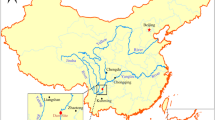Abstract
The seepage under a dam foundation is mainly controlled by the performance of the curtain. Its anti-seepage behavior may be weakened by the long term physic-chemical actions from groundwater. According to seepage hydraulics and geochemistry theory, a coupling model for assessing the behavior of the curtain under a dam foundation is set up, which consists of seepage module, solute transport module, geochemistry module and curtain erosion module, solved by FEM. A case study was carried out. The result shows that the curtain efficiency is weakened all the time. Aqueous calcium from the curtain is always in dissolution during the stress period for simulation, which leads to the increasing amount in groundwater reaching 846.35–865.312 g/m3. Within the domain, reaction extent differs in different parts of the curtain. The dissolution of Ca(OH)2 accounts to 877.884 g/m3 near the bottom and is much higher than that of the other parts. The erosion is much more serious near the bottom of the curtain than the other parts, which is the same to the upstream and downstream. Calcium dissolution is mainly controlled by hydraulic condition and dispersion, and it varies in a non-linear way within the domain.
Similar content being viewed by others
References
OUYANG Chang-yun. Technical problems about Geheyan Project’s seepage proof curtain [J]. Yangtze River, 1995, 6(5): 10–15. (in Chinese)
WU Zhong-ru, WANG Zhan-rui. Dynamic monitoring model of space displacement field of concrete dam [C]// International Symposium on Monitoring Technology of Dam Safety. 1992: 215–224.
GU Chong-shi, ZHANG Qian-fei. Research on seepage monitoring model of earth-rock dam [J]. Journal of Hydrodynamics, 2003, 16(1): 62–74.
FU Jun-feng, JIN Sheng. A study on unsteady seepage flow though dam [J]. Journal of Hydrodynamics, 2009, 21(5): 434–442.
YANG Guang-zhong, PENG Han-xing, MA Xiao-hui. Evaluation of seepage field of grouting curtain in Dan Jiangkou dam [J]. Journal of Hydroelectric Engineering, 2000(4): 33–39. (in Chinese)
SONG Han-zhou, ZHOU Jian, WANG Feng-bo. Study of groundwater quality evolution around dam-site and its significance [J]. Journal of Hydroelectric Engineering, 2004, 23(3): 74–78. (in Chinese).
TONG Hai-tao, SONG Han-zhou. Reliability analysis of stochastic modeling for water-rock interaction [J]. Chinese Journal of Rock Mechanics and Engineering, 2004, 23(12): 2010–2014. (in Chinese)
SHEN Zhen-zhong, CHEN Xiao-hu, XU Li-qun. Coupled analysis of stress-seepage interaction for gravity dam by element-free method [J]. Rock and Soil Mechanics, 2008, 29(11): 74–78. (in Chinese)
CHEN Xiao-ping, QIAN Ping-yi, LIANG Zhi-song. Coupled analysis of stress-seepage interaction for dam [J]. Rock and Soil Mechanics, 2008, 29(11): 74–78. (in Chinese)
DING Xiu-li, SHENG Qian. Seepage-stress coupled analysis on the dam foundation of 3# section in left bank power station of the three gorges project [J]. Chinese Journal of Rock Mechanics and Engineering, 2000, 19(s): 1001–1005. (in Chinese)
SHENG Jin-chang, SU Bao-yu, ZHAO Jian. Coupled stress and fluid analysis and concerned application in Xiluodu hydropower station [J]. Rock and Soil Mechanics, 2000, 21(4): 410–415. (in Chinese)
CHAI Jun-rui, LI Shou-yi. Analysis of coupled seepage and stress fields in rock mass around the Daliushu dam [J]. Chinese Journal of Rock Mechanics and Engineering, 2002, 21(s1): 2322–2325. (in Chinese)
CHAN D Y C, HUGHES B D. Transient flow around the boreholes [J]. Transport in Porous Media, 2003, 10(1): 137–152.
ALIM TURSUN. Numeric hydro-geo-chemical modeling of dam foundation ageing [D]. Nanjing: Hohai University, 2005. (in Chinese)
BABU D K, BANSAL P P. Analytical solution to Cl− flow through porous media [J]. Transport in Porous Media, 2005, 23(7): 17–19.
ZHAO Ming-deng, LI Tai-ru, HUAI Wen-xin. Finite proximate method for convection-diffusion equation [J]. Journal of Hydrodynamics, 2008, 20(1): 47–53.
ZHANG Qian-fei, LAN Shou-qi, XU Yong-fu. A new numerical method for groundwater flow and solution transport using velocity field [J]. Journal of Hydrodynamics, 2008, 20(3): 356–364.
TAN Ye-fei, ZHOU Zhi-fang. Simulation of solute transport in a parallel single fracture with LBM/MMP mixed method [J]. Journal of Hydrodynamics, 2008, 20(3): 365–372.
ZHOU Yan-zhang, ZHOU Zhi-fang. Simulation of thermal transport in aquifer: A GWHP system in Chengdu, China [J]. Journal of Hydrodynamics, 2009, 21(5): 647–657.
WANG Song-qing, ZHANG Xu. Variation characteristics of aquifer parameters induced by groundwater source heat pump operation under variable flow [J]. Journal of Central South University of Technology, 2011, 18(4): 1272–1277.
GERARD B, PIJAUDIER CABOT G, LA BORDERIE C. Coupled diffusion-damage modeling and the implications on failure due to strain localization [J]. International Journal of Solids and Structures, 1998, 35(30): 4107–4120.
COMSOL A B. Multi-physics version 3.4. User’s guide and reference guide [M]. Stockholm, 2009: 165–172.
WANG Jin-guo, ZHOU Zhi-fang, JIN Zhong-qing. Coupled method of method of BEM-FAM for simulation of groundwater thermal transport [J]. Journal of Hydrodynamics, 2001, 9(5): 71–76.
LI Min, DIAO Nai-ren, FANG Zhao-hong. Analysis of seepage flow in a confined aquifer with a standing column well [J]. Journal of Hydrodynamics, 2007, 19(1): 84–91.
WANG Guo-jian, CHENG Tong-jin, FAN Ming, REN Chun, CHEN Wei-jun. Laboratory simulation of vertical hydrocarbon micro seepage [J]. Acta Geological Sinica, 2011, 85(1): 223–232.
SHENG Jin-chang. Fully coupled thermo-hydro-mechanical model of saturated porous media and numerical modeling [J]. Chinese Journal of Rock Mechanics and Engineering, 2006, 25(s1): 3028–3033. (in Chinese)
Author information
Authors and Affiliations
Corresponding author
Additional information
Foundation item: Project(50139030) supported by the National Natural Science Foundation of China; Project(501072) supported by the Scientific Research Foundation for the Returned Overseas Scholars of the Ministry of Education of China
Rights and permissions
About this article
Cite this article
Peng, P., Shan, Zg. & Dong, Yf. Coupling model for assessing anti-seepage behavior of curtain under dam foundation. J. Cent. South Univ. 19, 2016–2021 (2012). https://doi.org/10.1007/s11771-012-1239-3
Received:
Accepted:
Published:
Issue Date:
DOI: https://doi.org/10.1007/s11771-012-1239-3




